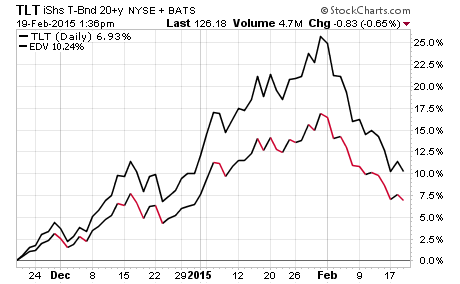The Only Move You Need to Make for Your ETF Bond Portfolio In 2015
Post on: 15 Июнь, 2015 No Comment

The performance of an investor’s bond portfolio is going to motivate changes this year
The Only Move You Need to Make for Your ETF Bond Portfolio In 2015
It’s been an amazing comeback year for the fixed-income markets following the interest rate volatility in 2013, especially in light of the sentiment statistics at the time calling for a steady rise for interest rates into 2015.
As a result, I doubt that many investors would have thought we would breach the psychologically significant 2% mark on the 10-year Treasury note in 2014.
It’s undeniably been an interesting year for domestic bond participants. Notable shake-ups have included fixed-income royalty Bill Gross leaving the firm he founded for a small competitor and quantitative easing finally coming to an end.
However, looking back over the last 12 months, it’s the performance of an investor’s bond portfolio that is going to motivate changes moving forward .
Which dredges up the age-old comparative anomaly, passive or active management in 2015?
With the full-year 2014 numbers almost in, investors in the highest rated actively-managed bond funds clearly came out on top once again. Using the Barclays Capital Aggregate Bond Index as the benchmark for all multi-sector and intermediate-term bond funds, it’s clear that managers that are granted the most levity used it to steer their portfolios away from index-like returns in treasury and agency securities. Instead, they coveted emerging market, corporate, and lower-rated issues.
Examining the year-to-date performance results of the benchmark’s corresponding exchange-traded fund counterparts, the iShares Barclays Aggregate Bond Fund ETF (AGG ) and the Vanguard Total Bond Market ETF (BND ). The total return tally resides at roughly 5.75%, which is palpable with rates already at very depressed levels. Not surprisingly there is nearly $50 billion in assets socked away in these two funds, with their general investor appeals being low fees and easy-to-understand product.
However, with just a small amount of research acumen, it’s easy to see that the index compilation methodology is overwhelmingly tilted toward the largest domestic issuers: The U.S. Treasury, government-sponsored enterprises and large corporations.
The crux of the problem with indexing fixed-income based on the amount of issuance or the size of the float is that it is fundamentally at odds with goal of the investor. As a debt investor, you would naturally focus on individual issuers that are assuming debt for productive purposes, such as capital expenditures, acquisitions or research and development. Furthermore, you would avoid abusive over-issuance, which could ultimately affect the credit rating of the debtor.
I will say first and foremost that I am a staunch advocate of indexing equities because I believe it is very difficult to construct a market-beating portfolio that can sustain its alpha year over year. On the other hand, I am in ardent opposition of indexing fixed-income due to the factors listed above. In addition, fixed-income assets have a maturity date, meaning they can never be bought into perpetuity like a stock can. As a result, the factors surrounding investment attractiveness such as yield, duration, price, call risk,and more are ever-changing based on each series of issuance.
It has been proven year over year that comprehensive credit research coupled with strategic yield-curve positioning and dynamic duration management can yield better results over time.
For unaware investors languishing in funds such as AGG and BND, I recommend using free services such as Morningstar or Yahoo Finance to research and compare actively managed fixed-income options. For clients in our Strategic Income Portfolio, we utilize funds such as the Pimco Income Fund Institutional Class (PIMIX ), the DoubleLine Total Return Bond Fund Class I (DBLTX ) and the Loomis Sayles Strategic Income Fund Class Y (NEZYX ) in different allocation sizes. In this manner, we can leverage different firm views alongside expertise in various sectors of the bond market. Not surprisingly, each fund on our list is very highly rated and has outperformed AGG and BND consistently for years.
While you don’t need to construct an overcomplicated portfolio, be mindful that managers tend to have a specialty of some sort. Identifying what that is and using it to your advantage will almost certainly yield excellent results over time.














